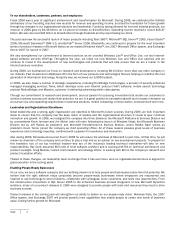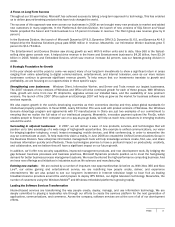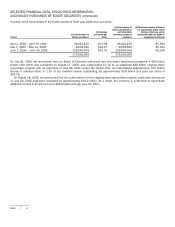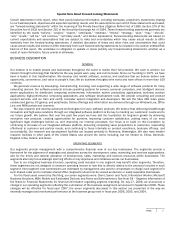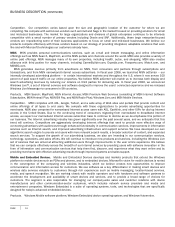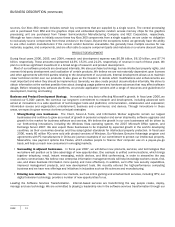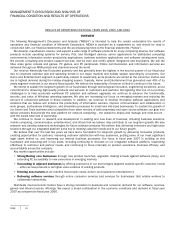Microsoft 2006 Annual Report Download - page 12
Download and view the complete annual report
Please find page 12 of the 2006 Microsoft annual report below. You can navigate through the pages in the report by either clicking on the pages listed below, or by using the keyword search tool below to find specific information within the annual report.
PAGE 11
Competition. Windows Mobile software faces substantial competition from Nokia, Openwave Systems, Palm, QUALCOMM,
Research In Motion, and Symbian. The embedded operating system segment is highly fragmented with many competitive
offerings. Key competitors include IBM, Wind River, and versions of embeddable Linux from commercial Linux vendors such as
Metrowerks and MontaVista Software. The telematics market is also highly fragmented, with competitive offerings from IBM and
automotive suppliers building on various real-time operating system platforms from commercial Linux vendors, QNX Software
Systems, Wind River, and others. We believe that our products compete effectively by providing a familiar development
framework, which enables developers to easily write and deploy innovative applications for mobile or embedded devices. We
also compete by providing a flexible platform that allows customers and partners to build differentiated and profitable business
models, and by providing end users with benefits such as ease of use, personal productivity, and better information
management and control.
Home and Entertainment. Home and Entertainment is responsible for development, production, and marketing for the Xbox
video game system, including consoles and accessories, third-party games, games published under the Microsoft brand, and
Xbox Live operations, research, and sales and support. In addition to Xbox, we offer several types of entertainment products,
including PC software games, online games, and other devices. The segment also leads the development efforts of our
Consumer Productivity Experience Group (“CPxG”) which includes Microsoft’s line of consumer software and hardware products,
such as the Encarta line of learning products and services, application software for Macintosh computers, and Microsoft PC
hardware products such as mice and keyboards. In addition, the segment carries out all retail sales and marketing for Microsoft
Office and the Windows operating systems (for which it receives an inter-segment commission), Xbox, PC games, and CPxG
products. It also is responsible for the development, sales, and deployment of Microsoft’s TV platform products for the
interactive television industry, including MSTV Foundation Edition and Internet Protocol TV products.
Products. Xbox 360; Xbox; Xbox Live; CPxG (consumer software and hardware products); and IPTV.
Competition. The home and entertainment business is highly competitive, characterized by rapid product life cycles, frequent
introductions of new products and titles, and the development of new technologies. The markets for our products are
characterized by significant price competition. We anticipate continued pricing pressure from our competitors. From time to
time, we have responded to this pressure by reducing prices on certain products. Our competitors vary in size from very small
companies with limited resources to very large, diversified corporations with substantial financial and marketing resources. We
compete primarily on the basis of product innovation, quality and variety, timing of product releases, and effectiveness of
distribution and marketing.
Our Xbox hardware business competes with console platforms from Nintendo and Sony, both of which have a large,
established base of customers. The lifecycle for video game consoles averages 5 to 7 years. We released Xbox 360, our next
generation console in November 2005. Nintendo and Sony have also announced new versions of their game consoles, which
have not been released. Success in the transition to the next generation of consoles will depend on the availability of games for
the console, providing exclusive game content that gamers seek, the computational power of the console, and the ability to
create new revenue sources such as advertising and downloadable content. We believe the Xbox 360 is positioned well against
competitive console products based on significant innovation in hardware architecture, new developer tools, expanded revenue
sources, and continued strong exclusive content from our own game franchises such as Halo.
In addition to competing against software published for non-Xbox platforms, our games business also competes with
numerous companies that we have licensed to develop and publish software for the Xbox consoles. Our PC hardware products
face aggressive competition from computer and other hardware manufacturers, many of which are also current or potential
partners. Our MSTV business faces competition primarily from ad hoc solutions that address sub-segments of the TV delivery
platform, but that do not provide end-to-end solutions for the network operator.
OPERATIONS
To serve the needs of customers around the world and to improve the quality and usability of products in international markets,
we “localize” many of our products to reflect local languages and conventions. Localizing a product may require modifying the
user interface, altering dialog boxes, and translating text.
Our operational centers support all operations in their regions, including customer contract and order processing, credit and
collections, information processing and vendor management and logistics. The regional center in Ireland supports the EMEA
region; the center in Singapore supports the Japan, Greater China and Asia-Pacific region; and the centers in Fargo, Puerto Rico,
Reno, and Redmond support North America and Latin America.
We contract most of our manufacturing activities to third parties who produce the Xbox, various retail software packaged
products, and Microsoft hardware. Our products may include some components that are available from only one or limited



